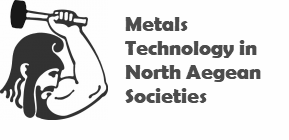North Aegean landscapes of metal production
- Nerantzis Nerantzis

- Jan 9, 2020
- 3 min read
Updated: Jan 15, 2020
The North Aegean, which is the region of study, consists of Eastern Macedonia and Thrace with the adjacent islands of Thasos and Samothrace and is characterised by a mosaic of picturesque river valleys, lowland plains and mountainous landscapes. The underground world of minerals and metals is particularly important in this part of Greece since a number of mines, and landscapes of industrial activity bear witness to its unique technological past. Although the landscapes of natural beauty and archaeological significance have been generally described at various instances such as in guidebooks and historical treatises there is only limited mention to the sites of mining or smelting (extracting the metal through metallurgy) that were used to produce gold, silver, lead, copper and iron. The realization that such localities have been crucial for the economy and development of local communities has meant that any industrial site represents a resource of technological heritage which is worthy of detailed study, preservation and protection.
Ancient mining galleries exposed by modern exploitation (Mandra Kari mine, Lekani mountain range, Kavala Prefecture)
Some early attempts to investigate the organization of metals extraction in this region during antiquity were initiated in the 1980’s when several mining and metallurgical sites have been located across Mount Pangaion, the Lekani mountain range and Thasos. The then IH΄ Ephorate of Prehistoric and Classical Antiquities and the Institute for Geological and Mineral Explorations (IGME) were responsible for these pioneering efforts to locate and document the evidence on the field (Koukouli-Chrysanthaki 1990; Photos et al. 1986; 1989). Combined archaeological research, field surveys and laboratory analysis on metallurgical residues, provided tangible material evidence testifying to a diachronic exploitation of the local mineral deposits spanning from the Final Neolithic/Early Bronze Age up to Byzantine and Ottoman periods (Kostoglou 2008; Nerantzis 2010; Nerantzis and Papadopoulos 2013; Vaxevanopoulos et al. 2017; Bassiakos et al. 2019). The broad distribution of production sites and their associations to contemporary rural settlement and urban centres has demonstrated variation in how communities organised themselves in production and exercised technological choices for particular landscape settings. This diversity remains to be fully explored and better understood in terms of chronology and specific variations through time.
Slag deposits deriving from large scale metallurgical activities of the 15th-16th centuries AD (Livadia-Nikisiani, Mount Pangaion, Kavala Prefecture)
In recent years it became clear that trying to understand the technical developments in transforming minerals into metals involves examining the social organization and cultural context within which the communities of the region interacted with their natural environment. Thus further issues have started being addressed such as settlement patterns, the organization of space as a reflection of social relationships, degrees of social stratification directly linked to labour division and scales of specialization in crafting (Nerantzis 2016).
One of the implications of this work is to promote awareness among both the public and professionals of the importance of metallurgical landscapes. The rapid deterioration of slag heaps due to the re-use of slag as raw material for road construction calls for a basic strategic plan to promote recording and protection of sites of past industrial activities.
References
Bassiakos, Y., Nerantzis, N. and Papadopoulos, S. (2019) Late Neolithic/Early Bronze Age
metallurgical practices at Limenaria, Thasos: evidence for silver and copper production,
Archaeological and Anthropological Sciences 11(6): 2743-2757.
Kostoglou, M. (2008) Iron and Steel in Ancient Greece: Artefacts, Technology and Social Change in Aegean Thrace from Classical to Roman Times, British Archaeological Reports International Series 1883, Oxford, Archaeopress.
Koukouli-Chrysanthaki, Ch. (1990) Τα «μέταλλα» της Θασιακής Περαίας, Μνήμη Δ. Λαζαρίδη: Πόλις και Χώρα στην Αρχαία Μακεδονία και Θράκη, Πρακτικά Αρχαιολογικού Συνεδρίου (Καβάλα 1986), Ελληνογαλλικές Έρευνες Ι. Θεσσανολίκη, 493-514.
Nerantzis, N. (2010) Byzantine and Ottoman Mineral Exploration and Smelting in Eastern Macedonia, Greece and their Implications for Regional Economies, Unpublished PhD Thesis, University of Sheffield.
Nerantzis, N. (2016) Pre-Industrial Iron Smelting and Silver Extraction in North-eastern Greece: An Archaeometallurgical Approach, Archaeometry 58(4): 624-641.
Nerantzis, N. and Papadopoulos, S. (2013) Reassessment and new data on the diachronic relationship of Thassos Island with its indigenous metal resources: a review. Archaeological and Anthropological Sciences 5(3):183-196.
Photos, E., Koukouli-Chrysanthaki, Ch. and Gialoglou, G. (1986) Extractive Iron Metallurgy on Thasos and the East Macedonian mainland, in R.E. Jones and H.W. Catling (eds.) Science in Archaeology, Proc. Meeting held at the British School at Athens. Fitch Laboratory Occasional Paper 2, 43-47.
Photos, E., Koukouli-Chrysanthaki, C., Tylecote, R.F. and Gialoglou, G. (1989) Precious Metals Extraction in Palaia Kavala, NE Greece, An Archaeometallurgical Attempt to Locate Skapte Hyle. International Old World Archaeometallurgy Conference, Der Anschnitt. Heidelberg: Max Plank Institut fur Kern Physik, 179-190.
Vaxevanopoulos, M., Vavelidis, M., Malamidou, D. and Melfos, V. (2017) Ανασκαφική έρευνα σε αρχαία μεταλλεία και μεταλλουργικές θέσεις του όρους Παγγαίου (Ασημότρυπες, Βαλτούδα), ΑΕΜΘ 26 (2012), 547-552.









Comments